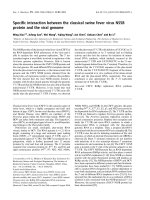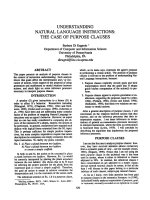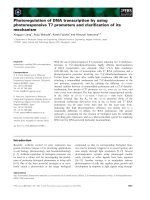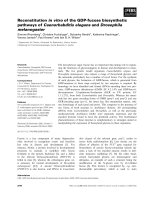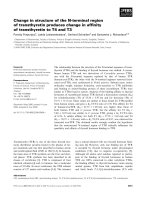báo cáo khoa học: "Linkage in cattle between the major histocompatibility complex (BoLA) and the M blood group system" doc
Bạn đang xem bản rút gọn của tài liệu. Xem và tải ngay bản đầy đủ của tài liệu tại đây (587.39 KB, 11 trang )
Linkage
in
cattle
between
the
major
histocompatibility
complex
(BoLA)
and
the
M
blood
group
system
H.
LEVEZIEL
H.C.
HINES
I.N.R.A.,
Laboratoire
de
Genetique
biochimique,
Centre
de
Recherches
zootechniques,
F
78350
Jouy-en-Josas
*
Immunogenetics
Laboratory,
Department
of
Dairy
Science,
The
Ohio
State
University,
2027
Coffey
Road,
Columbus,
Ohio
43210,
U.S.A.
Summary
Relationships
between
the
bovine
Major
Histocompatibility
Complex
(MHC)
and
11
blood
group
systems
were
examined
using
genetic
information
obtained
from
58
families
with
doubly-hete-
rozygous
parents.
The
data
were
analyzed
by
the
lod-score
method:
Close
to
moderate
linkage
between
the
cattle
MHC
(BoLA
complex)
and
10
blood
group
loci,
A,
B,
C,
F,
J,
L,
S,
Z,
R’
and
T’
was
excluded.
Evidence
for
a
close
linkage
between
BoLA
and
the
M
blood
group
system
is
presented
and
a
recombination
frequency
of
0.04
was
estimated.
The
possibility
of
a
linkage
disequilibrium
in
the
BoLA-M
system
chromosomal
region
is
suggested.
Key
words :
Cattle,
histocompatibility,
blood
groups,
linkage.
Résumé
Liaison
génétique
entre
le
Complexe
Majeur
d’Histocompatibilité
(BoLA)
et
le
système
M
de
groupes
sanguins
des
bovins
Les
relations
entre
le
Complexe
Majeur
d’Histocompatibilité
(CMH)
des
bovins
et
les
11
systèmes
de
groupes
sanguins
ont
été
examinées
en
utilisant
l’information
génétique
recueillie
dans
58
familles
de
parents
double-hétérozygotes.
Les
données
ont
été
analysées
par
la
méthode
du
lod-score.
Toute
liaison
génétique
étroite
ou
modérée
entre
le
CMH
bovin
(complexe
BO
LA)
et
10
des
loci
de
groupes
sanguins :
A,
B,
C,
F,
J,
L,
S,
Z,
R’
et
T’ est
exclue.
L’existence
d’une
liaison
génétique
étroite
entre
BoLA
et
le
système
M
de
groupes
sanguins
est
établie,
avec
une
fréquence
de
recombinaison
estimée
à
0,04.
La
possibilité
d’un
déséquilibre
de
liaison
au
sein
de
la
région
chromosomique
BoLA-système
M
est
suggérée.
Mots
clés :
Bovins,
histocompatibilité,
groupes
sanguins,
liaison
génétique.
1.
Introduction
Following
the
demonstration
of
an
essential
biological
role
for
the
Major
Histocom-
patibility
Complex
(MHC)
in
other
species
studied
(reviewed
in
G
OTZE
,
1977),
research
on
the
cattle
MHC
has
progressed
enormously
during
the
last
few
years.
Previously,
only
the
erythrocyte
blood
group
systems
were
well
known.
Among
the
11
systems
identified,
2
complex
systems
had
been
considered
as
prime
candidates
for
the
hypothe-
tical
MHC
of
cattle :
the
B
system
because
of
its
genetic
diversity
(O
OSTERLEE
&
Bouw,
1974 ;
R
UITERKAMP
et
al.,
1977),
and
the
S
system
because
of
its
serological
complexity
(G
ROSC
LAUDE
,
1965 ;
BOROVSK
A
&
DEMANT,
1967 ;
IVANYI,
1973).
Subsequent
reports
from
several
laboratories :
Me
G
ARY
&
STONE
(1970),
S
CHMID
&
C
WIK
(1972),
O
STRANT
-
R
OSENBERG
&
S
TORM
O
NT
(1974),
B
RYAN
et
al.
(1975),
and
FO
LGER
&
H
INES
(1976)
suggested
that
lymphocyte
antigens
were
not
under
the
control
of
these
loci.
The
existence
of
the
cattle
MHC
(BoLA
Complex)
is
now
well
established
(reviewed
by
STONE,
1982).
Studied
independently
by
C
ALDWELL
et
al.
(1977),
A
MORENA
&
STONE
(1978),
and
S
POONER
et
al.
(1978),
the
BoLA
Complex
encodes
for
17
class
I
antigens
(see
Proceedings,
1982)
controlled
by
the
BoLA-A
locus
(OLIVER
et
al.,
1981),
class
II
antigens
(H
OANG
-X
UAN
et
al. ,
1982 ;
N
EWMANN
et
al. ,
1982),
and
contains
a
BO
LA-D
locus
controlling
the
mixed
lymphocyte
reaction
(U
SINGER
et
al.,
1981).
In
their
first
publication
S
POONER
et
al.
(1978)
presented
preliminary
evidence
that
there
did
not
appear
to
be
any
identity
or
close
linkage
between
the
BoLA
locus
and
any
blood
group
loci.
They
always
observed
the
presence
of
the
’4
possible
genetic
types
in
offspring
of
doubly-heterozygous
bulls,
but
the
data
were
in
some
cases
limited.
The
data
need
to
be
expanded
and
the
results
confirmed.
This
paper
presents
analyses
for
genetic
linkage
between
BoLA
and
eleven
bovine
blood
group
loci
on
data
compiled
from
typing
in
France
and
in
the
United
States.
II.
Materials
and
methods
A.
Animals
The
animals
used
in
these
studies
were
from
13
different
breeds :
Normande,
Française-Frisonne,
Maine-Anjou,
Holstein,
Angus,
Hereford,
Limousin,
Simmental,
Chianina,
Ayrshire,
Guernsey,
Jersey
and
Brangus.
They
were
primarily
from
private
farms
in
France
as
well
as
in
the
United
States,
with
additional
animals
from
experimental
herds
of
the
D6partement
de
Génétique
animale
(Institut
National
de
la
Recherche
Agronomique,
France),
and
from
the
university
herds
in
the
U.S.A.
at
The
Ohio
State
University
(Department
of
Dairy
Science)
and
at
the
University
of
Wisconsin
(Depart-
ment
of
Agriculture).
They
consisted
of
dam-offspring
pairs,
generally
half-sib
families
from
artificial
insemination
sires,
but
in
some
cases
in
the
U.S.A.
were
full-sib
families
obtained
by
embryo
transfer.
Some
of
the
latter
families
were
included
in
the
Second
North
American
Comparison
Test,
1982.
Correctness
of
parentage
was
verified
by
BO
LA
and
blood
group
typing.
Offspring
with
parentage
incompatibilities
were
not
included
in
the
linkage
evaluations.
B.
BO
LA
typing
The
BoLA
typing
of
these
animals
has
been
determined
by
the
lymphocytotoxicity
test,
as
previously
described
in
detail
in
our
publications :
S
POONER
et
al.
(1978),
and
N
EWMAN
&
HtrrES
(1979).
The
cytotoxic
sera
used
in
France
were
produced
by
skin
grafts
and
purified
by
absorption
(S
POONER
et
al. ,
1978) ;
in
Ohio,
they
were
usually
obtained
by
screening
and
selecting
sera
from
foeto-maternal
immunizations
(H
INES
&
N
EWMAN
,
1981),
and
in
fewer
cases
were
obtained
by
skin
grafts
or
by
immunization
with
lymphocytes
followed
by
absorption.
All of
these
sera
were
submitted
to
the
last
International
BoLA
Comparison
Test
in
1980
(see
Proceedings,
1982).
C.
Blood
Group
Typing
The
blood
group
typing
was
performed
by
the
Laboratoire
des
groupes
sanguins
des
bovins,
I.N.R.A.,
C.N.R.Z.,
Jouy-en-Josas,
France,
and
by
the
Cattle
Blood
Typing
Laboratory,
The
Ohio
State
University,
Colombus,
Ohio,
U.S.A.
The
typing
was
done
by
standard
hemolytic
procedures,
according
to
the
techniques
described
in
detail
by
G
ROSCLAUDE
et
Cil.
(1979),
and
H
INES
et
al.
(1977).
The
nomenclature
used
is
that
of
the
last
international
comparison
test
organized
by
the
International
Society
for
Animal
Blood
Group
Research
(I.S.A.B.R.)
in
1981.
D.
Analysis
The
data
analysis
was
performed by
the
lod-score :
sequential
probability
method
developed
by
M
ORTON
(1955)
for
the
detection
of
genetic
linkage
in
familial
data.
The
Z
value
of —
2
and
+
3
were
considered
respectively
to
exclude
or
to
accept
the
existence
of
a
linkage.
In
some
cases,
the x
z
to
estimate
the
heterogeneity
of
the
information
between
different
families
was
calculated
as
indicated
by
CAV
ALLI
-S
FORZA
&
BO
DME
R
(1971).
Results
The
information
collected
in
58
families
of
doubly-heterozygous
parents
enabled
us
to
determine
the
following
genetic linkage
relationships
between
the
BoLA
complex
and
the
blood
group
loci :
1)
Absence
of
close
or
moderate
linkage
between
BoLA
and
10
of
the
erythrocyte
blood
group
systems
The
calculated
lod-score
values
(Z
values)
shown
in
table
1
exclude
close
or
moderate
linkage
between
the
bovine
MHC
and
10 of
the
blood
group
systems :
the
Z
values
are
always
less
than —
2
for
recombination
rates
of
0.2
or
lower ;
the
values
of
(3
up-
to
which
linkage
can
be
excluded
for
each
system
range
from
0.21
(system
L)
to
0.37
(system
C).
Over
these
values,
the
lod-score
are
always
negative
up
to
O
=
0.50
for
systems
A,
C,
J,
Z
and
R’,
whereas
positive
maximum
values
are
obtained
for
systems
B,
F,
L,
S and
T’.
Genetic
linkage
between
BoLA
and
the
M
system
Table
2
lists
all
families
relevant
to
analyses
for
linkage
between
BoLA
and
the
M
system :
the
details
pertaining
to
the
BoLA
genotype,
the
M
genotype,
the
number
of
informative
matings,
and
the
segregation
of
the
gametes
within
the
offspring.
The
genes
for
M’
and
M,
was
inherited
respectively
from
6
sires
and
from
6
sires
and
1
cow.
Only
5
putative
recombinants
occured
within
the
family
of
the
bull
VALMIN.
Table
3
gives
the
lod-score
values
obtained
for
M’
and
for
the
M,
factor,
and
shows
clearly
the
existence
of
genetic
linkage
between
the
BoLA
complex
and
each
of
the
2
factors.
The
Z
values
for
the
«
M
»
system
are
obtained
by
addition
of
the
values
for
M’
and
M,,
and
we
observe
a
lod-score
value
always
greater
than
+
3.0.
The
estimation
of
the
recombination
rate
between
BoLA
and
the
M
system
is
O
=
0.04,
giving
a
maximum
value
for
Z
of
29.13.
Furthermore,
in
using
as
maximum
value
the
limiting
value
for
Z
when
O
=
0.00,
the
X2
for
heterogeneity
does
not
indicate
any
divergence
between
the
information
collected
in
M’
segregating
families
and
in
M,
segregating
families.
The
existence
of
a
linkage disequilibrium
within
the
BoLA
region
is
also
suggested
by
the
observation
that
all
M’
bulls
involved
in
this
linkage
study
share
the
W16
specificity
and
that
they
all
transmit
the
combination
W16-M’
in
opposition
to
their
other
haplotypes
(see
tabl.
2).
Similarly,
all
M,
bulls
or
cows
have
local
BoLA
specificities
called
FJM1
in
France
or
OH26
in
Ohio,
and
in
each
case
the
haplotypes
FJM1-M,
or
OH26-M,
are
inherited
by
the
offspring.
III.
Discussion
and
conclusions
The
sequential
probability
test
provides
a
powerful
method
of
examining
the
pos-
sibility
of
chromosomal
linkage
between
loci.
The
extensive
diversity
at
the
BoLA
and
several
of
the
bovine
blood
group
loci
permitted
the
accumulation
of
large
amounts
of
data
for
most
paired-locus
combinations.
This
allowed
conclusions
about
linkage
to
be
reached
with
considerable
assurance.
The
extensive
polymorphic
variation
also
permitted
the
recognition
of
most
instances
of
incorrectly
recorded
parentage.
Although
fewer
families
were
studied
in
France
(20)
than
in
the
United
States
(38),
the
French
data
made
a
greater
contribution
to
the
linkage
analysis.
The
situation
can
be
explained
by
family
structure
differences
between
the
2
sets
of
data.
In
France
the
paternal
half-sib
families
were
fewer
but
larger,
while
in
the
United
States
although
more
families
were
examined,
there
were
fewer
offspring
per
family.
In
any
case,
a
good
agreement
between
the
results
was
observed
and
we
report
only
the
cumulative
values
of
the
lod-score.
For
the
A,
L,
R’
and
T’
systems,
conclusions
could
not
have
been
reached
without
combining
the
data.
The
first
result
we
have
established
is
the
absence
of
close
or
moderate
genetic
linkage
between
BoLA
and
10 of
the
blood
group
loci.
This
definitely
eliminates
any
possibility
of
identity
between
BoLA
and
any
of
these
systems ;
they
must
now
be
considered
as
strictly
separate.
That
conclusion
is
of
fundamental
interest,
especially
for
the
complex
systems
B,
C
and
S.
The
hypothesis
of
R
UITERKAMP
et
l
ll.
(1977),
who
compared
the
bovine
B
system
to
the
H-2
complex
in
mice
and
suggested
the
B
system
could
be
the
bovine
MHC,
is
now
formally
dismissed.
Furthermore,
recent
publications
of
G
ROSCLAUDE
et
ltl.
(1979,
1981)
and
G
UERIN
et
al.
(1981)
which
have
contributed
to
the
elaboration
of
linear
genetic
maps
for
the
B and
C
systems
have
suggested
that
in
addition
to
their
genetic
independance,
these
complex
systems
have
a
genetic
structure
distinguishable
from
the
classical
structure
of
the
MHC
(A
NTCZAK
,
1982).
Similarly,
the
hypothesis
that
the
S
system
could
be
the
cattle
MHC,
suggested
by
the
observation
of
serological
complexity
with
the
existence
of
non-linear
subgroups,
must
now
be
disregarded.
No
firm
conclusions
can
be
drawn
from
our
results
regarding
the
possibility
of
loose
linkage.
However,
positive
maximum
lod-scores
were
obtained
for
5
blood
group
systems
which,
although
not
significant,
could
still
represent
loose
linkage
between
any one
of
these
systems
and
BoLA.
Such
linkage,
if
it
exists,
is
unlikely
to
concern
more
than
2
of
the
5
(one
on
either
side
of
BoLA)
since
it
is
known
that
there
is
no
close
or
moderate
linkage
between
any
of
the
5
systems
in
question.
Although
further
data
are
required
to
resolve
the
above
point
it
is
nevertheless
clear
that
the
BO
LA
complex
constitutes
a
separate
genetic
system
which
is
independent
of
the
A,
B,
C,
F,
J,
L,
S,
Z,
R’
and
T’
blood
group
systems.
A
completely
different
situation
occurs
when
the
relationship
between
the
M
system
and
the
MHC
is
considered.
M
system
factors,
first
reported
in
1942
by
F
ER
G
USON
et
al.
and
elaborated
upon
in
1950
by
S
TORM
O
NT
,
appear
to
be
under
the
control
of
an
eleventh
independent
blood
group
system
as
was
demonstrated
by
R
ENDEL
(1958).
Today,
2
antigenic
factors,
M,
and
M’,
are
recognized
but
the
gene
frequencies
of
the
encoding
alleles
are
low,
and
the
«
null
» allele
has
a
frequency
higher
than
0.90
in
almost
all
breeds
tested.
The
control
of
these
2
factors
by
alleles
of
a
single
locus
has
been
assumed
on
the
basis
of
serological
cross-reactivity
of
the
antigenic
determinants,
but
the
critical
family
studies
have
not
been
reported.
First
suspected
in
only
one
bull
family
(a
Normand
bull :
VALMIN)
in
which
the
M,
factor
was
segregating
(L
EVEZ
iEL
&
G
UERIN
,
1980)
the
linkage
between
BoLA
and
the
M
system
had
to
be
confirmed
in
other
families
in
which
the
segregation
of
the
M’
factor
could
be
analysed
before
it
could
be
definitively
established.
Our
results,
utilizing
families
from
different
breeds
for
each
of
the
factors
M,
and
M’,
establish
existence
of
a
genetic
linkage
between
the
BoLA
complex
and
the
M
blood
group
locus.
The
calculated
recombination
rate
of
O
=
0.04
between
the
BoLA
and
M
loci
must
be
regarded
with
some
reservation
and
may
be
an
overestimation ;
all
5
putative
«
recom-
binants
»
occurred
among
the
progeny
of
a
single
sire
(VALMIN)
but
this
family
was
tested
between
1977
and
1979
and
the
recombinants
were
no
longer
available
for
retesting
and
absorption
studies
when
the
linkage
between
BoLA
and
M
became
apparent
at
a
later
date.
However,
the
extensive
blood
group
polymorphisms
for
which
these
animals
were
tested
represent
a
powerful
means
of
diagnosing
incorrect
parentage
and
this
was
not
the
case
for
any
of
the
apparent
recombinants.
Furthermore
the
fact
that
so
many
recombinants
were
found
in
the
same
family,
although
unusual,
should
not
necessarily
be
regarded
with
suspicion
since
it
is
known
that,
in
stallions,
there
may
be
notable
differences
in
recombination
rates
between
sires
(A
NDERSSON
&
S
ANDBERG
,
1984).
In
any
case,
we
are
dealing
with
close
linkage ;
the
confidence
limits
calculated
using
the
Poisson
distribution
are
0.011
<
O
<
0.083
(P
=
0.95 ;
symmetrical
in
probability).
The
absence
of
heterogeneity
between
the
familial
data
for
M,
and
M’
supports
the
belief
that
these
2
factors
are
controlled
by
the
same
locus,
or
by
2
closely
linked
loci
since
their
segregation
in
combination
with
BoLA
antigens
does
not
differ
signifi-
cantly.
However,
only
the
segregation
from
parents
with
M’IM
I
and
correspondingly
heterozygous
BoLA
genotypes
will
provide
data
pertinent
to
conclusive
resolution
of
the
question.
The
existence
of
a
linkage
between
the
MHC
and
blood
group
loci
has
been
described
in
other
species ;
in
that
regard,
the
bovine
species
does
not
constitute
a
special
case.
A
linkage
has
been
reported
in
swine
between
the
SLA
complex
and
the
J
and
C
blood
group
loci
(H
RUBAN
et
al. ,
1976).
Linkages
between
MHC
and
blood
,
groups
are
known
in
rabbits
(T
ISSOT
&
C
OHEN
,
1974)
and
in
horses
too
(BAILEY
et
al.,
1979).
The
B
complex
of
chickens
constitutes
the
only
MHC
which
includes
encoding
for
antigens
specific
for
erythrocytes
(P
INK et
al. ,
1977)
and
their
progenitor
cells
(L
ONGENECKER
&
Moshtwrtrr,
1981).
Other
interesting
situations
arise
in
the
mouse
and
human,
where
the
blood
groups
H2-G
and
Chido/Rodgers,
respectively
associated
with
H-2
and
HLA
complexes,
appeared
to
be
serologically
detected
products
of
within
MHC
complement
genes
(F
ERREIRA
et
al.,
1980 ;
O’NELL et
al.,
1978).
Thus,
it
will
be
worth
comparing
the
bovine
situation
to
those
different
models
in
the
future.
In
addition
to
the
genetic
linkage
we
observed,
we
suggest
the
probable
existence
of
a
linkage
disequilibrium
in
the
BoLA
region.
This
is
an
important
characteristic
of
all
other
well-studied
MHC
S,
and
we
report
here
the
first
such
evidence
in
cattle.
The
local
designations
FJM
I
or
OH26
(which
may
possibly
represent
the
same
specificity)
are
not
as
well
defined
as
W16 ;
they
behave
as
extra
reactions
recognized
by
our
anti-W6
or
anti-W16
sera
in
France
or
by
anti-W6.2
sera
in
Ohio ;
nevertheless,
in
our
data
all
parents
transmitted
either
the
haplotype
W16-M’
or
the
haplotypes
FJM
I-
M,/OH26-M,
to
their
progeny.
If
this
linkage
disequilibrium
could
be
confirmed
at
the
population
level
and
in
several
breeds
(as
seems
to
be
the
case
in
the
French
Pie-Noire
and
U.S.
Holstein
breed
for
W16-M’,
and
in
the
U.S.
Angus
breed
for
OH26-M
l
;
unpublished),
it
would
strengthen
the
analogy
between
BoLA
and
the
other
MHC
S.
In
the
light
of
our
findings
and
the
already
described
associations
between
HLA
and
diseases
in
man
(D
AUSSET
,
1976),
or
between
SLA
and
performance
traits
in
swine
(C
APY
et
al.,
1981),
earlier
reports
of
the
relationship
of
M
blood
group
genes
or
associated
BoLA
haplotypes
with
physiological
traits
take
on
a
new
significance.
The
publication
by
M
ITSCHERLICH
et
al.
(1959)
of
negative
association
between
the
M
blood
group
antigen
and
milk
production,
the
communication
by
S
OLBU
et
al.
(1982)
concerning
a
possible
association
between
the
W16
haplotype
and
an
increased
susceptibility
to
mastitis
and
the
recently
evidenced
association
of
the
M
blood
group
factor
with
suscep-
tibility
to
mastitis
(L
ARSEN
et
al. ,
1983),
have
to
be
considered with
the
greatest
attention,
taking
in
account
our
fundamental
observations.
Thus
in
addition
to
a
better
description
of
the
BoLA
region,
the
linkage
we
have
established
and
the
linkage
disequilibrium
we
suggest
lend
support
to
the
previously
reported
genetic
marker
associations.
Additio-
nal
investigations
of
relationships
between
the
complex
and
measures
of
physiological
performance
appear
to
hold
promise.
Received
December
23,
1983.
Accepted
February
21,
1984.
Acknowledgements
The
authors
would
like
to
thank
all
those
who
participated
both
in
France
and
in
the
United
States,
and
made
possible
the
accumulation
of
large
amounts
of
data
required
for
the
genetic
study.
References
A
MORENA
B.,
STONE
W.H.,
1978.
Serologically
Defined
(SD)
locus
in
cattle. Science,
201, 159-160.
A
NDERSSON
L.,
S
ANDBERG
K.,
1984.
Genetic
linkage
in
the
horse.
II.
Distribution
of
male
recom-
bination
estimates
and
the
influence
of
age,
breed
and
sex
on
recombination
frequency.
Genetics,
106,
109-122.
A
NTCZAK
D.F.,
1982.
Structure
and
function
of
the
major
histocompatibility
complex
in
domestic
animals.
J.
Am.
Vet.
Med.
Assoc.,
181,
1030-1036.
BAILEY
E.,
S
TORMONT
C.,
S
UZUKI
Y.,
T
ROMMERSHAUSEN
-S
MITH
A.,
1979.
Linkage
of loci
controlling
alloantigens
on
red
blood
cells
and
lymphocytes
in
the
horse.
Science,
204,
1317-1319.
B
OROVSKA
M.,
D
EMANT
P.,
1967.
Specificity
of
cytotoxic
antibodies
in
typing
sera
against
cattle
blood
group
antigens.
Folia
Biol.
Praha,
13,
473-475.
B
RYAN
C.,
C
ALDWELL
J.,
W
ESELI
D.F.,
1975.
Analysis
of
the
cattle
histocompatibility
system.
J.
Anim.
Sci.,
41,
247.
C
ALDWELL
J.,
B
RYAN
C.F.,
C
UMBERLAND
P.A.,
W
ESELI
D.F.,
1977.
Serologically
detected
lympho-
cytes
antigens
of
Holstein
cattle.
Anim.
Blood
Grps.
Biochem.
Genet.,
8,
197-207.
C
APY
P.,
R
ENARD
C.,
S
ELLIER
P.,
V
AIMAN
M.,
1981.
Etude
pr6liminaire
des
relations
entre
le
complexe
majeur
d’histocompatibilité
(SLA)
et
des
caractères
de
production
chez
le
porc.
Ann.
Genet.
Sel.
Anim.,
13,
441-446.
C
AVALLI
-S
FOZA
L.L.,
B
ODMER
W.F.,
1971.
The
Genetics
of human
populations.
965
pp.,
Freeman
W.H.
&
Co,
San
Francisco.
D
AUSSET
J.,
1976.
Le
complexe
HLA.
Les
associations
entre
HLA
et
maladies.
Nouv.
Presse
M
éd.,
5,
1477-1482.
F
ERGUSON
L.C.,
S
TORMONT
C.,
I
RWIN
M.R.,
1942.
On
additional
antigens.
in
the
erythrocytes
of
cattle.
J.
lmmunol.,
44,
147-164.
FE
RREIRA
A.,
DAVID
C.S.,
N
USSENZWEIG
V.,
1980.
The
murine
H-2.7
specificity
is
an
antigenic
determinant
of
C4d,
a
fragment
of
the
fourth
component
of
the
Complement
System.
J.
Exp.
Med.,
151,
1424-1435.
FoLGER
R.L.,
H
INES
H.C.,
1976.
Bovine
Lymphocyte
antigens :
Serological
relationships
with
erythrocyte
and
spermatozoan
antigens.
Anim.
Blood
Grps.
Biochem.
Genet.,
7,
137-145.
G
OTZE
D.
(ed.),
1977.
The
major
histocompatibily
system
in
man
and
animals.
404
pp.,
Springer
Verlag,
Berlin.
G
ROS
C
LAUDE
F.,
1965.
Studies
on
the
S
blood
group
system
in
French
cattle
breeds.
Proceedings
of the
9th
European
Conference
on
Animal
Blood
Groups,
Prague,
18-22
August
1964,
Publishing
House
of
the
Czechoslovak
Academy
of
Sciences,
Prague,
79-85.
G
ROS
C
LAUDE
F.,
G
UERIN
G.,
H
OULIER
G.,
1979.
The
genetic
map
of
the
B
system
of
cattle
blood
groups
as
observed
in
French
breeds.
Anim.
Blood
Grps.
Biochem.
Genet.,
10,
199-218.
G
ROSCLAUDE
F.,
A
LAUX
M.T.,
H
OULIER
G.,
G
UERIN
G.,
1981.
The
C
system
of
cattle
blood
groups.
1.
Additional
factors
in
the
system.
Anim.
Blood
Grps.
Biochem.
Genet.,
12,
7-14.
G
UERIN
G.,
G
ROSCLAUDE
F.,
H
OULIER
G.,
1981.
The
C
system
of
cattle
blood
groups.
2.
Partial
genetic
map
of
the
system.
Anim.
Blood
Grps.
Biochem.
Genet.,
12,
15-21.
H
INES
H.C.,
H
AENLEIN
G.F.W.,
Z
IKAKIS
J.P.,
DICKEY
H.C.,
1977.
Blood
antigen,
serum
protein,
and
milk
protein
gene
frequencies
and
genetic
interrelationships
in
Holstein
cattle.
J.
Dairy
Sci.,
60,
1143-1151.
H
INES
H.C.,
N
EWMAN
M.J.,
1981.
Production
of
foetally
stimulated
lymphocytotoxic
antibodies
by
multiparous
cows.
Anim.
Blood
Grps.
Biochem.
Genet.,
12,
201-206.
H
OANG
-X
UAN
M.,
C
HARR
ON
D.,
Z
ILBER
M.T.,
LEVY
D.,
1982.
Biochemical
characterization
of
class
II
bovine
major
histocompatibility
complex
antigens
using
cross-species
reactive
antibodies.
Immunogenetics,
15,
621-624.
H
RUBAN
V.,
SIMON
M.,
H
RADECKY
J.,
J
ILE
x
F.,
1976.
Linkage
of
the
pig
main
histocompatibility
complex
and
the
J
blood
group
system.
Tissue
Antigens,
7,
267-271.
I
VANYI
P.,
1973.
The
major
histocompatibility
antigens
in
various
species.
Curr.
Top.
Microbiol.
Immunol.,
53,
1-90.
L
ARSEN
B.,
JENSEN
N.E.,
MA
DSE
N
P.,
N
IELSEN
S.M.,
KLASTRUP
0.,
MA
DSEN
P.S.,
1983.
Blood
groups
in
relation
to
bovine
mastitis.
34th
Annual
Meeting
of
the
European
Association
for
Animal
Production,
Madrid,
3-6
October
1983
(Summaries),
1,
359.
L
EVEZIEL
H.,
G
UERIN
G.,
1980.
An
attempt
to
detect
genetic
linkage
between
the
major
bovine
histocompatibility
system
and
other
genetic
markers.
l7th
Conference
on
Animal
Blood
Groups
and
Biochemical
Polymorphisms,
Wageningen,
28
July -
7
August
1980,
roneotyped
abstracts,
138
pp.,
44.
L
ONGENECKER
B.M.,
M
OSMANN
T.R.,
1981.
Structure
and
properties
of
the
major
histocompatibility
complex
of
the
chicken.
Speculations
on
the
advantages
and
evolution of
polymorphism.
lmmunogenetics,
13,
1-23.
McGARY
D.R.,
STONE
W.H.,
1970.
Immunogenetics
studies
of
cattle
lymphocytes
(abst.).
Fed.
Proc.,
29,
508.
M
ITSCHERLICH
V.E.,
T
OLLE
E.,
W
ALTER
E.,
1959.
Untersuchungen
uber
das
Bestehen
von
Bezie-
hungen
zwischen
Blutgruppenfaktoren
und
Milchleistung
des
Rindes.
Z.
Tierz.
Ziichtungbiol.,
72,
289-301.
M
ORTON
N.E.,
1955.
Sequential
tests
for
the
detection
of
linkage.
Am.
J.
Hum.
Genet.,
7,
177-318.
N
EWMAN
M.J.,
H
INES
H.C.,
1979.
Production
of
foetally
stimulated
lymphocytotoxic
antibodies
by
primiparous
cows.
Anim.
Blood
Grps.
Biochem.
Genet.,
10,
87-92.
N
EWMAN
M.J.,
A
DAMS
T.E.,
B
RANDON
M.R.,
1982.
Serological
and
genetic
identification
of
a
bovine
B
lymphocyte
alloantigen
system.
Anim.
Blood
Grps.
Biochem.
Genet.,
13,
123-139.
OLIVER
R.A.,
MC
C
OUBRE
Y
C.M.,
M
ILLAR
P.,
M
OR
GAN
A.L.G.,
SP
OO
NER
R.L.,
1981.
A
genetic
.
study
of
bovine
lymphocyte
antigens
(BoLA)
and
their
frequency
in
several
breeds.
Immuno-
genetics,
13,
127-132.
O’N
EILL
G.J.,
YANG
S.Y.,
T
EGOLI
J.,
B
ERGER
R.,
D
UPONT
B.,
1978.
Chido
and
Rodgers
blood
groups
are
distinct
antigenic
components
of
human
complement
C4.
Nature,
273,
668-670.
O
OSTERLEE
C.O.,
Bouw
J.,
1974.
Structure
of
«
loci
» in
animals.
«
Loci
» structure
in
animal
blood
groups.
Ist
World
Congress
on
Genetics
Applied
to
Livestock
Production,
Madrid,
7-11
October
1974,
1,
243-252,
Editorial
Garsi,
Madrid.
O
STRAND
-R
OSENBERG
S.,
S
TORMONT
C.,
1974.
Bovine
leucocyte
antigens.
Anim.
Blood
Grps.
Biochem.
Genet.,
5,
231-237.
PINK
J.R.L.,
M
IGGIAN
O
V.C.,
Z
IEGLER
A.,
1977.
Antigens
of
the
chicken
major
histocompatibility
B
complex.
Folia
Biol.
Praha,
23,
404-405.
«
PROCEEDINGS
»,
1982.
Proceeding
of
the
Second
International
Bovine
Lymphocyte
Antigen
(BoLA)
workshop,
1982.
Anim.
Blood
Grps.
Biochem.
Genet.,
13,
33-53.
R
ENDEL
J.,
1958.
Studies
of
cattle
blood
groups.
I.
Production
of
cattle
isoimmune
sera
and
the
inheritance
of
4
antigenic
factors.
Acta
Agric.
Scand.,
8,
40-61.
R
UITERKAMP
W.A.,
SPECK
C.M.,
Bouw
J.,
1977.
Structure
of
the
blood
group
system
B
in
cattle.
II.
A
comparison
between
the
blood
group
system
B
in
cattle
and
the
histocompatibility
system
H-2
in
mice.
Anim.
Blood
Grps.
Biochem.
Genet.
(Abstracts
of papers
read
at
the
15th
European
Conference
on
Animal
Blood
Groups
and
Biochemical
Polymorphisms,
Dublin,
17-17
July
1976),
8
(suppl.
1),
9.
S
CHMID
D.O.,
Cmx
S.,
1972.
On
leucocyte
serology
in
the
pig
and
cattle. Anim.
Blood
Grps.
Biochem.
Genet.
(Abstracts
of papers
read
at
the
13th
European
Conference
on
Animal
Blood
Groups
and
Biochemical
Polymorphisms,
Vienna,
26 June -
7
July
1972),
3
(suppl.
1),
11-12.
S
OLBU
H.,
S
POONER
R.L.,
LIE
O.,
1982.
A
possible
influence
of
the
bovine
major
histocompatibility
complex
(BoLA)
on
mastitis.
2nd
World
Congress
on
Genetics
Applied
to
Livestock
Production,
Madrid,
4-8
October
1982,
7,
368-371,
Editorial
Garsi,
Madrid.
SPOO
NER
R.L.,
LEVEZIEL
H.,
GROSCL
AUDE
F.,
OLIVER
R.A.,
VAIMAN
M.,
1978.
Evidence
for
a
possible
major
histocompatibility
complex
(BLA)
in
cattle.
J.
Immunogenetics,
5,
335-346.
STONE
W.H.,
1982.
The
bovine
lymphocyte
antigen
(BoLA)
system.
Adv.
Exp.
Med.
Biol.,
137,
433-450.
S
TORMONT
C.,
1950.
Additional
gene-controlled
antigenic
factors
in
the
bovine
erythrocyte.
Genetics,
35,
76-94.
T
ISSOT
R.G.,
C
OHEN
C.,
1974.
Histocompatibility
in
the
rabbit.
Linkage
between
RL-A,
MLC,
and
the
He
blood
group
loci.
Transplantation,
18,
142-149.
USINGER
W.R.,
CURIE-COHEN
M.,
BENFORADO
K.,
PRINGNITZ
D.,
ROWE
R.,
SPLITTER
G.A.,
STONE
W.H.,
1981.
The
bovine
major
histocompatibility
complex
(BoLA) :
close
linkage
of
the
gene
controlling
serologically
defined
antigens
and
mixed
lymphocyte
reactivity.
Immuno-
genetics,
14,
423-428.

